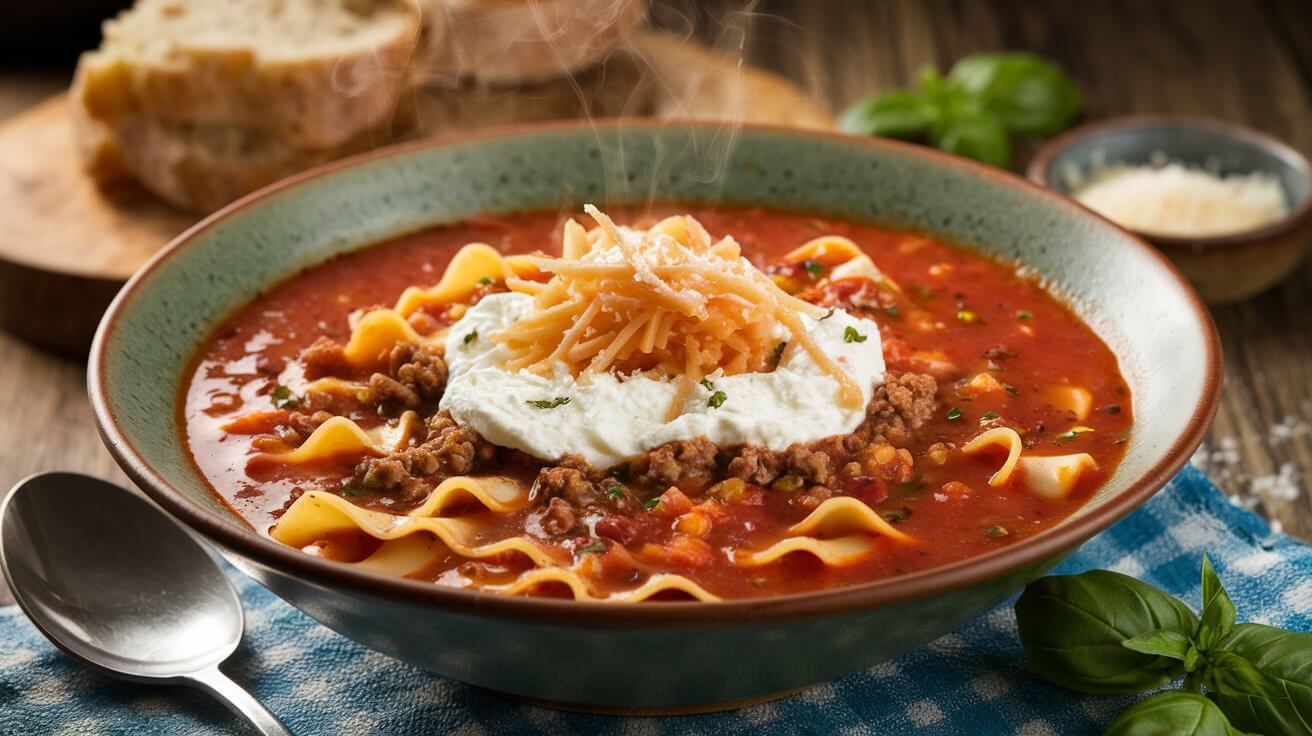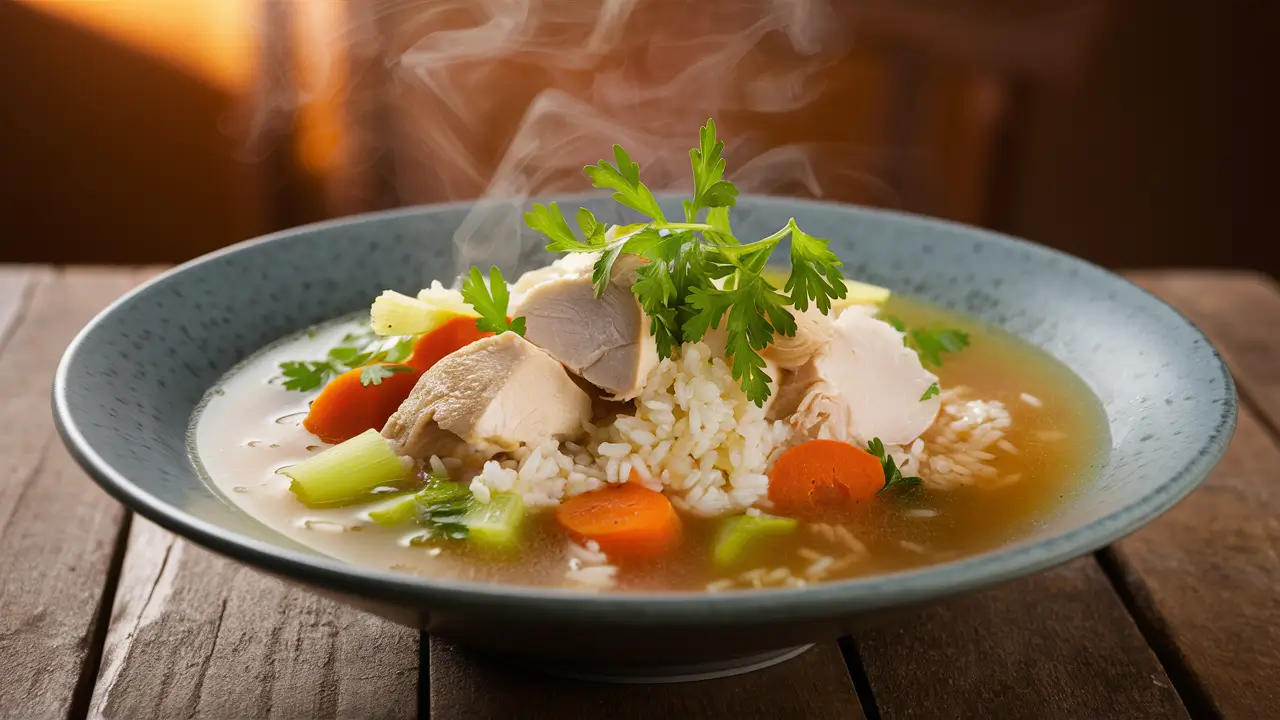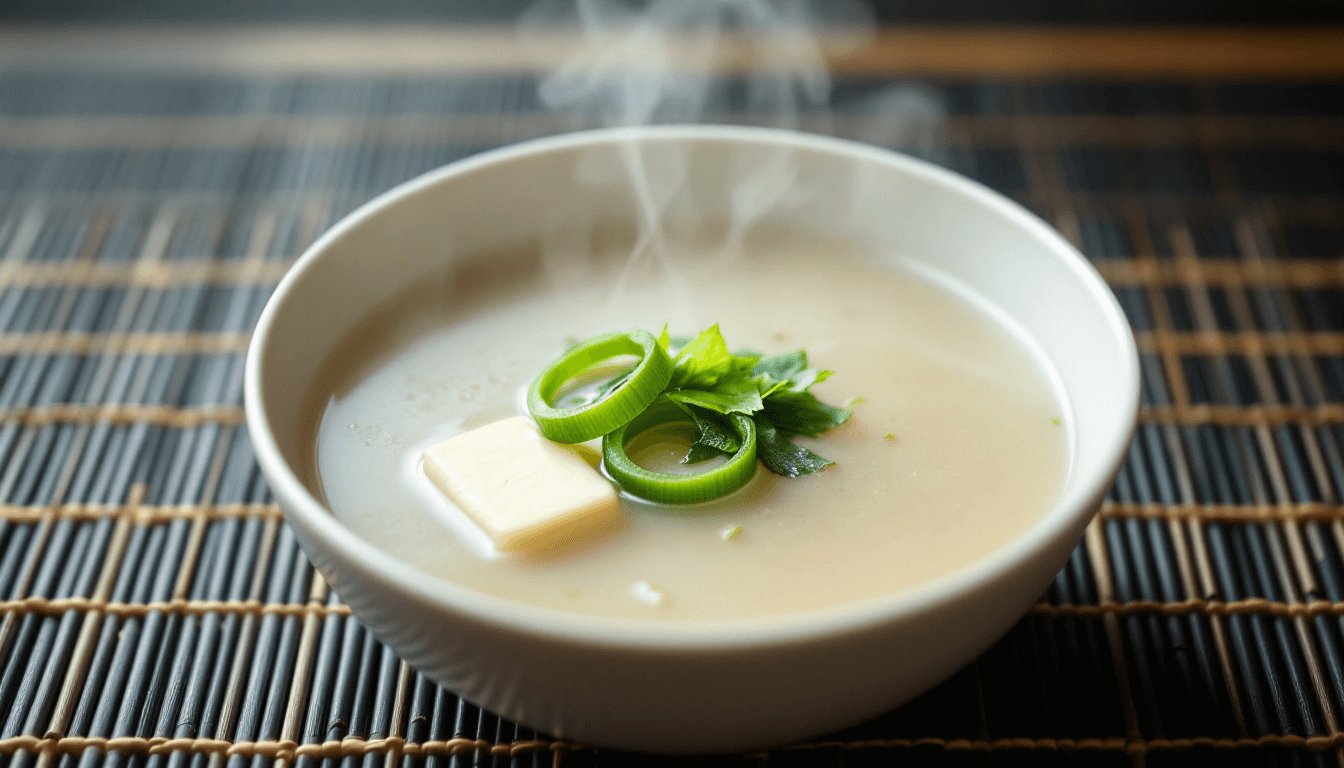Ultimate Lasagna Soup Recipe: Cozy Comfort in a Bowl (30-Minute Meal)

Lasagna soup is a delightful culinary creation that combines the rich, hearty flavors of traditional lasagna with the comforting warmth of a soup. This innovative dish has gained popularity in recent years, offering a quicker and easier way to enjoy the taste of lasagna without the lengthy preparation time. In this comprehensive guide, we’ll explore everything you need to know about lasagna soup, from its origins to various recipes and tips for perfecting this crowd-pleasing meal.
Table of Contents
- Introduction to Lasagna Soup
- The History and Evolution of Lasagna Soup
- Essential Ingredients for Lasagna Soup
- Step-by-Step Classic Lasagna Soup Recipe
- Variations on the Traditional Recipe
- Tips for Perfecting Your Lasagna Soup
- Nutritional Information and Dietary Adaptations
- Serving and Presentation Ideas
- Storing and Reheating Lasagna Soup
- Pairing Suggestions: Sides and Drinks
- Frequently Asked Questions about Lasagna Soup
- Conclusion: Embracing the Comfort of Lasagna Soup
Introduction to Lasagna Soup
Lasagna soup is a creative and comforting dish that transforms the beloved Italian casserole into a hearty, spoonable meal. It captures the essence of traditional lasagna – layers of pasta, meat sauce, and cheese – in a warm, broth-based soup. This innovative approach to lasagna offers all the flavors you love in a format that’s quicker to prepare and perfect for those cozy nights when you crave something warm and satisfying.
The beauty of lasagna soup lies in its versatility and ease of preparation. It’s a one-pot wonder that can be customized to suit various tastes and dietary needs. Whether you’re a meat lover, vegetarian, or somewhere in between, there’s a lasagna soup recipe that’s sure to please your palate.
The History and Evolution of Lasagna Soup
While the exact origins of lasagna soup are not well-documented, it’s clear that this dish is a modern interpretation of the classic Italian lasagna. Traditional lasagna, with its roots tracing back to ancient Rome, has been a staple of Italian cuisine for centuries. The transformation of this layered pasta dish into a soup format is likely a result of the culinary trend towards deconstructed and reimagined classic dishes.
Lasagna soup began gaining popularity in the early 2010s, particularly in the United States. Food bloggers and home cooks started experimenting with ways to capture the flavors of lasagna in a more convenient format. The soup version addressed some of the challenges associated with traditional lasagna, such as long baking times and the difficulty of portioning.
As the concept spread, various versions of lasagna soup emerged, each putting its own spin on the basic idea. Some recipes stay true to the classic lasagna flavors, while others incorporate unique ingredients or cater to specific dietary requirements.
Essential Ingredients for Lasagna Soup
To create a delicious lasagna soup, you’ll need ingredients that mirror those found in traditional lasagna. Here’s a breakdown of the key components:
- Pasta:
- Lasagna noodles, broken into pieces
- Alternatives: fusilli, farfalle, or any short pasta shape
- Meat:
- Ground beef (80/20 lean-to-fat ratio is ideal)
- Italian sausage (optional, for added flavor)
- Vegetables:
- Onions
- Garlic
- Carrots (optional)
- Spinach or kale (optional, for added nutrition)
- Tomato Base:
- Crushed tomatoes
- Tomato paste
- Marinara sauce (optional, for added depth)
- Broth:
- Beef broth or chicken broth
- Vegetable broth (for vegetarian versions)
- Herbs and Spices:
- Dried oregano
- Dried basil
- Red pepper flakes
- Salt and black pepper
- Cheese:
- Ricotta cheese
- Mozzarella cheese
- Parmesan cheese
- Additional Flavoring:
- Olive oil
- Bay leaves
- Balsamic vinegar (optional, for depth of flavor)
Step-by-Step Classic Lasagna Soup Recipe
Now, let’s dive into a classic lasagna soup recipe that serves 6-8 people:
Ingredients:
- 1 pound ground beef
- 1 pound Italian sausage, casings removed
- 1 large onion, diced
- 4 cloves garlic, minced
- 2 carrots, diced (optional)
- 1 can (28 oz) crushed tomatoes
- 2 tablespoons tomato paste
- 6 cups beef broth
- 2 teaspoons dried oregano
- 2 teaspoons dried basil
- 1/2 teaspoon red pepper flakes
- 2 bay leaves
- Salt and black pepper to taste
- 8 lasagna noodles, broken into pieces
- 1 cup ricotta cheese
- 1 cup shredded mozzarella cheese
- 1/2 cup grated Parmesan cheese
- Fresh basil leaves for garnish
Instructions:
- In a large pot or Dutch oven, brown the ground beef and Italian sausage over medium-high heat, breaking it up with a wooden spoon as it cooks. Drain excess fat if necessary.
- Add the diced onion and carrots (if using) to the pot. Cook for 5-7 minutes until the vegetables start to soften.
- Add minced garlic and cook for another minute until fragrant.
- Stir in the crushed tomatoes, tomato paste, and beef broth. Mix well to combine.
- Add dried oregano, dried basil, red pepper flakes, bay leaves, salt, and black pepper. Stir to incorporate all the seasonings.
- Bring the soup to a boil, then reduce heat and simmer for 20-25 minutes to allow the flavors to meld.
- Add the broken lasagna noodles to the pot and cook for an additional 8-10 minutes or until the pasta is al dente.
- While the pasta is cooking, prepare the cheese mixture by combining ricotta, mozzarella, and Parmesan cheeses in a bowl.
- Once the pasta is cooked, remove the bay leaves from the soup.
- To serve, ladle the hot soup into bowls and top each serving with a generous dollop of the cheese mixture.
- Garnish with fresh basil leaves and additional Parmesan cheese if desired.
- Allow the cheese to melt slightly before serving, creating a gooey, lasagna-like experience.
Variations on the Traditional Recipe
One of the joys of lasagna soup is its adaptability. Here are some popular variations to try:
- Vegetarian Lasagna Soup:
- Replace meat with plant-based alternatives or additional vegetables like zucchini, bell peppers, and mushrooms.
- Use vegetable broth instead of beef broth.
- Creamy Lasagna Soup:
- Add 1 cup of heavy cream or half-and-half to the soup for a richer texture.
- Increase the amount of ricotta cheese for extra creaminess.
- Slow Cooker Lasagna Soup:
- Brown the meat and sauté vegetables before adding to the slow cooker.
- Cook on low for 6-8 hours, adding pasta in the last 30 minutes.
- Spicy Lasagna Soup:
- Increase the amount of red pepper flakes or add diced jalapeños for heat.
- Use spicy Italian sausage for an extra kick.
- White Lasagna Soup:
- Replace tomato-based ingredients with a creamy white sauce made from butter, flour, and milk.
- Add chicken instead of beef for a lighter flavor profile.
- Seafood Lasagna Soup:
- Use a combination of shrimp, scallops, and white fish instead of meat.
- Incorporate a seafood broth for a more authentic flavor.
- Low-Carb Lasagna Soup:
- Replace lasagna noodles with zucchini noodles or cauliflower florets.
- Increase the amount of vegetables for added bulk.
Tips for Perfecting Your Lasagna Soup
To ensure your lasagna soup is a hit every time, consider these helpful tips:
- Choose the Right Pasta:
- If using lasagna noodles, break them into bite-sized pieces for easier eating.
- Cook the pasta separately and add it to individual bowls if you plan on having leftovers to prevent the noodles from becoming soggy.
- Layer the Flavors:
- Start by browning the meat to develop a deep flavor base.
- Sauté aromatics like onions and garlic before adding liquids.
- Balance the Seasonings:
- Taste and adjust seasonings throughout the cooking process.
- Remember that flavors will intensify as the soup simmers.
- Mind the Texture:
- For a thicker soup, let it simmer uncovered to reduce.
- For a thinner consistency, add more broth as needed.
- Cheese Considerations:
- Reserve some cheese for topping each bowl just before serving.
- For a more authentic lasagna experience, broil the cheese-topped soup for a few minutes to achieve a bubbly, golden crust.
- Make It Ahead:
- Prepare the soup base in advance, but add the pasta just before serving to maintain its texture.
- The flavors often improve after a day in the refrigerator.
- Garnish Creatively:
- Fresh herbs like basil or parsley add color and freshness.
- A drizzle of high-quality olive oil can elevate the final presentation.
Nutritional Information and Dietary Adaptations
While lasagna soup is undoubtedly comforting, it’s important to be aware of its nutritional content. A typical serving of lasagna soup (about 1.5 cups) contains approximately:
- Calories: 400-500
- Protein: 25-30g
- Carbohydrates: 30-40g
- Fat: 20-25g
- Fiber: 3-5g
These values can vary significantly based on the specific ingredients and proportions used. For those looking to adapt the recipe to fit specific dietary needs, consider the following modifications:
- Lower Calorie Version:
- Use lean ground turkey or chicken instead of beef.
- Reduce the amount of cheese or use low-fat alternatives.
- Increase the proportion of vegetables to meat and pasta.
- Gluten-Free Adaptation:
- Use gluten-free lasagna noodles or other gluten-free pasta shapes.
- Ensure all broths and seasonings are certified gluten-free.
- Dairy-Free Option:
- Omit the cheese or use dairy-free alternatives like cashew ricotta.
- Use nutritional yeast for a cheesy flavor without dairy.
- High-Protein Version:
- Add extra lean ground beef or turkey.
- Incorporate protein-rich beans like kidney beans or white beans.
- Vegetarian/Vegan Adaptation:
- Use plant-based meat substitutes or increase vegetables and beans.
- Replace cheese with vegan alternatives or nutritional yeast.
Remember to consult with a nutritionist or healthcare provider if you have specific dietary concerns or restrictions.
Serving and Presentation Ideas
Elevate your lasagna soup experience with these serving and presentation suggestions:
- Bowl Selection:
- Use wide, shallow bowls to showcase the soup’s components.
- Opt for oven-safe bowls if you plan to broil the cheese topping.
- Cheese Topping Techniques:
- Create a “cheese pull” effect by adding a generous amount of mozzarella on top.
- Use a kitchen torch to melt and slightly brown the cheese for a gourmet touch.
- Garnish Artfully:
- Arrange fresh basil leaves in a decorative pattern.
- Sprinkle with a combination of herbs for color contrast.
- Accompaniments:
- Serve with a side of garlic bread or breadsticks for dipping.
- Offer extra Parmesan cheese and red pepper flakes on the side.
- Family-Style Serving:
- Present the soup in a large, decorative pot at the center of the table.
- Provide a ladle and allow guests to serve themselves.
- Individual Ramekins:
- For a more formal presentation, serve individual portions in oven-safe ramekins.
- Broil each serving separately for a personalized touch.
- Deconstructed Presentation:
- Serve the soup base, pasta, and cheese toppings separately.
- Allow diners to assemble their own bowls for a interactive dining experience.
Storing and Reheating Lasagna Soup
Proper storage and reheating techniques ensure that your lasagna soup remains delicious for days after it’s made:
- Cooling:
- Allow the soup to cool to room temperature before storing.
- Do not leave the soup at room temperature for more than 2 hours.
- Storage Containers:
- Use airtight containers to prevent absorption of other flavors in the refrigerator.
- If storing with pasta, keep in mind that the noodles will continue to absorb liquid.
- Refrigeration:
- Store in the refrigerator for up to 3-4 days.
- For best results, store the soup base and pasta separately.
- Freezing:
- Freeze the soup base without pasta for up to 3 months.
- Thaw in the refrigerator overnight before reheating.
- Reheating on Stovetop:
- Warm over medium heat, stirring occasionally.
- Add a splash of broth or water if the soup has thickened too much.
- Microwave Reheating:
- Heat in microwave-safe containers in 1-minute intervals, stirring between each interval.
- Be cautious of hot spots and uneven heating.
- Adding Fresh Elements:
- When reheating, consider adding fresh herbs or a new cheese topping to refresh the flavors.
Pairing Suggestions: Sides and Drinks
Enhance your lasagna soup meal with these complementary side dishes and beverage pairings:
- Side Salads:
- Caesar salad
- Mixed green salad with balsamic vinaigrette
- Caprese salad
- Bread Options:
- Garlic bread
- Focaccia
- Crusty Italian bread
- Vegetable Sides:
- Roasted broccoli
- Sautéed spinach with garlic
- Grilled zucchini
- Wine Pairings:
- Chianti
- Sangiovese
- Pinot Noir
- Beer Selections:
- Italian lager
- Amber ale
- Wheat beer
- Non-Alcoholic Beverages:
- Sparkling water with lemon
- Iced tea
- Italian soda
Remember to consider the flavors in your specific lasagna soup recipe when choosing pairings. The goal is to complement, not overpower, the soup’s taste profile.
Frequently Asked Questions about Lasagna Soup
- Can I make lasagna soup ahead of time? Yes, you can prepare the soup base in advance. Add the pasta just before serving to prevent it from becoming too soft.
- How do I prevent the noodles from getting mushy? Cook the noodles separately and add them to individual bowls when serving. Alternatively, slightly undercook the noodles in the soup, as they will continue to absorb liquid as they sit.
- Can I use different types of pasta instead of lasagna noodles? Absolutely! Feel free to use other short pasta shapes like fusilli, farfalle, or even broken spaghetti. The key is to choose a pasta that will hold up well in the soup.
- Is it possible to make a vegetarian version of lasagna soup? Yes, you can easily make a vegetarian version by omitting the meat and using vegetable broth. Add extra vegetables like zucchini, bell peppers, and mushrooms for more substance.
- How can I make my lasagna soup thicker? To thicken the soup, you can let it simmer uncovered for a longer time, add a bit more tomato paste, or stir in some cornstarch slurry (mix 1 tablespoon cornstarch with 2 tablespoons cold water before adding).
- Can I use a slow cooker to make lasagna soup? Yes, lasagna soup adapts well to slow cooking. Brown the meat and sauté the vegetables before adding to the slow cooker, then cook on low for 6-8 hours. Add the pasta in the last 30 minutes of cooking.
- How long does lasagna soup last in the refrigerator? Properly stored in an airtight container, lasagna soup will last 3-4 days in the refrigerator. The flavors often improve after a day or two.
- Can lasagna soup be frozen? Yes, you can freeze the soup base (without pasta) for up to 3 months. Thaw overnight in the refrigerator and reheat gently on the stove, adding fresh pasta when serving.
- What’s the best cheese to use for lasagna soup? A combination of ricotta, mozzarella, and Parmesan cheese mimics the classic lasagna flavor profile. However, feel free to experiment with other Italian cheeses like Asiago or Pecorino Romano.
- How can I make my lasagna soup spicier? Increase the amount of red pepper flakes, add some diced jalapeños, or use spicy Italian sausage instead of regular sausage for an extra kick.
Conclusion: Embracing the Comfort of Lasagna Soup
Lasagna soup is more than just a clever twist on a classic Italian dish; it’s a celebration of comfort food that brings together the best elements of lasagna in a convenient, customizable format. This versatile recipe allows for endless variations, making it suitable for various dietary needs and personal preferences.
The beauty of lasagna soup lies in its ability to deliver the rich, satisfying flavors of traditional lasagna without the time-consuming layering and baking process. It’s a perfect solution for busy weeknights when you crave something hearty and comforting but don’t have hours to spend in the kitchen.
Moreover, the communal nature of soup makes lasagna soup an excellent choice for gatherings. It’s easy to serve, can be prepared in large batches, and is sure to please a crowd. The interactive element of adding your own toppings allows each person to customize their bowl to their liking, making it a fun and engaging meal for family dinners or casual get-togethers.
As you experiment with different variations of lasagna soup, don’t be afraid to get creative. The basic recipe serves as a canvas for your culinary imagination. Whether you’re adding unique vegetables, trying different cheese combinations, or incorporating unexpected spices, each pot of lasagna soup is an opportunity to create something delicious and uniquely yours.
Remember that cooking is as much about the process as it is about the end result. Enjoy the aromas that fill your kitchen as the soup simmers, the satisfaction of stirring a pot of something truly comforting, and the joy of sharing a warm, nourishing meal with those you care about.
In embracing lasagna soup, you’re not just making a meal; you’re creating an experience that combines tradition, innovation, and the simple pleasure of good food. So grab your ladle, gather your ingredients, and get ready to dive into a bowl of pure comfort. Your perfect lasagna soup awaits!




